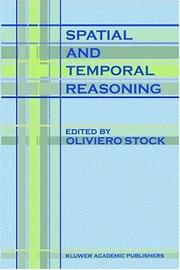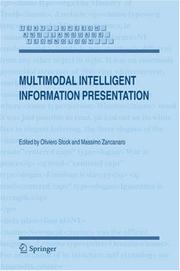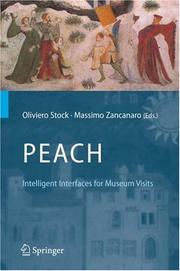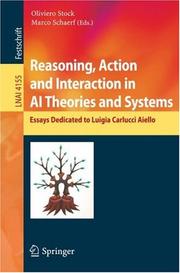| Listing 1 - 10 of 15 | << page >> |
Sort by
|

ISBN: 0792346440 0792347161 0585283222 Year: 1997 Publisher: Dordrecht ; Boston : Kluwer Academic Publishers,
Abstract | Keywords | Export | Availability | Bookmark
 Loading...
Loading...Choose an application
- Reference Manager
- EndNote
- RefWorks (Direct export to RefWorks)
Qualitative reasoning about space and time - a reasoning at the human level - promises to become a fundamental aspect of future systems that will accompany us in daily activity. The aim of Spatial and Temporal Reasoning is to give a picture of current research in this area focusing on both representational and computational issues. The picture emphasizes some major lines of development in this multifaceted, constantly growing area. The material in the book also shows some common ground and a novel combination of spatial and temporal aspects of qualitative reasoning. Part I presents the overall scene. The chapter by Laure Vieu is on the state of the art in spatial representation and reasoning, and that by Alfonso Gerevini gives a similar survey on research in temporal reasoning. The specific contributions to these areas are then grouped in the two main parts. In Part II, Roberto Casati and Achille Varzi examine the ontological status of spatial entities; Anthony Cohn, Brandon Bennett, John Gooday, and Nicholas Gotts present a detailed theory of reasoning with qualitative relations about regions; Andrew Frank discusses the spatial needs of geographical information systems; and Annette Herskovits focuses on the linguistic expression of spatial relations. In Part III, James Allen and George Ferguson describe an interval temporal logic for the representation of actions and events; Drew McDermott presents an efficient way of predicting the outcome of plan execution; and Erik Sandewall introduces a semantics based on transitions for assessing theories of action and change. In Part IV, Antony Galton's chapter stands clearly between the two areas of space and time and outlines the main coordinates of an integrated approach.
Artificial intelligence. Robotics. Simulation. Graphics --- Qualitative reasoning --- Artificial intelligence --- Knowledge representation (Information theory) --- Space perception --- Raisonnement qualitatif --- Intelligence artificielle --- Représentation des connaissances --- Perception spatiale --- 800:311 --- Spatial perception --- Perception --- Spatial behavior --- Figure-ground perception --- Geographical perception --- Reasoning --- Representation of knowledge (Information theory) --- Information theory --- AI (Artificial intelligence) --- Artificial thinking --- Electronic brains --- Intellectronics --- Intelligence, Artificial --- Intelligent machines --- Machine intelligence --- Thinking, Artificial --- Bionics --- Cognitive science --- Digital computer simulation --- Electronic data processing --- Logic machines --- Machine theory --- Self-organizing systems --- Simulation methods --- Fifth generation computers --- Neural computers --- Kwantitatieve linguistiek. Computerlinguistiek --- Artificial intelligence. --- Qualitative reasoning. --- Space perception. --- Geografie --- Geografische Informatie Systemen --- Gi Wetenschap. --- Computational linguistics. --- Computer science. --- Data structures (Computer scienc. --- Knowledge representation (Information theory). --- Linguistics. --- Computer Science --- Engineering & Applied Sciences --- 800:311 Kwantitatieve linguistiek. Computerlinguistiek --- Représentation des connaissances --- EPUB-LIV-FT SPRINGER-B --- Data structures (Computer science). --- Computational Linguistics. --- Artificial Intelligence (incl. Robotics). --- Data Structures, Cryptology and Information Theory. --- Computer Science, general. --- Artificial Intelligence. --- Data Structures and Information Theory. --- Informatics --- Science --- Information structures (Computer science) --- Structures, Data (Computer science) --- Structures, Information (Computer science) --- File organization (Computer science) --- Abstract data types (Computer science) --- Automatic language processing --- Language and languages --- Language data processing --- Linguistics --- Natural language processing (Linguistics) --- Applied linguistics --- Cross-language information retrieval --- Mathematical linguistics --- Multilingual computing --- Data processing

ISBN: 1280283246 9786610283248 1402030517 1402030495 1402030509 Year: 2005 Publisher: Dordrecht, Netherlands : Norwell, MA : Springer ; Sold and distributed in North, Central, and South America by Springer,
Abstract | Keywords | Export | Availability | Bookmark
 Loading...
Loading...Choose an application
- Reference Manager
- EndNote
- RefWorks (Direct export to RefWorks)
Intelligent Multimodal Information Presentation relates to the ability of a computer system to automatically produce interactive information presentations, taking into account the specifics about the user, such as needs, interests and knowledge, and engaging in a collaborative interaction that helps the retrieval of relevant information and its understanding on the part of the user. The volume includes descriptions of some of the most representative recent works on Intelligent Information Presentation and a view of the challenges ahead.
Linguistics. --- Multimedia information systems. --- User interfaces (Computer systems). --- Artificial intelligence. --- Computational linguistics. --- Application software. --- Computational Linguistics. --- Computer Applications. --- Language Translation and Linguistics. --- Multimedia Information Systems. --- User Interfaces and Human Computer Interaction. --- Artificial Intelligence (incl. Robotics). --- AI (Artificial intelligence) --- Artificial thinking --- Electronic brains --- Intellectronics --- Intelligence, Artificial --- Intelligent machines --- Machine intelligence --- Thinking, Artificial --- Bionics --- Cognitive science --- Digital computer simulation --- Electronic data processing --- Logic machines --- Machine theory --- Self-organizing systems --- Simulation methods --- Fifth generation computers --- Neural computers --- Application computer programs --- Application computer software --- Applications software --- Apps (Computer software) --- Computer software --- Automatic language processing --- Language and languages --- Language data processing --- Linguistics --- Natural language processing (Linguistics) --- Applied linguistics --- Cross-language information retrieval --- Mathematical linguistics --- Multilingual computing --- Interfaces, User (Computer systems) --- Human-machine systems --- Human-computer interaction --- Computer-based multimedia information systems --- Multimedia computing --- Multimedia information systems --- Multimedia knowledge systems --- Information storage and retrieval systems --- Linguistic science --- Science of language --- Data processing --- User interfaces (Computer systems) --- Human-computer interaction. --- Interfaces utilisateurs (Informatique) --- Interaction homme-machine (Informatique) --- Intelligence artificielle. --- Computer-human interaction --- Human factors in computing systems --- Interaction, Human-computer --- Human engineering --- User-centered system design --- Computer science. --- Natural language processing (Computer science). --- Multimedia systems. --- Natural Language Processing (NLP). --- Artificial Intelligence. --- NLP (Computer science) --- Artificial intelligence --- Semantic computing --- Informatics --- Science
Digital
ISBN: 9781402030512 Year: 2005 Publisher: Dordrecht Springer
Abstract | Keywords | Export | Availability | Bookmark
 Loading...
Loading...Choose an application
- Reference Manager
- EndNote
- RefWorks (Direct export to RefWorks)
Computer architecture. Operating systems --- Artificial intelligence. Robotics. Simulation. Graphics --- Computer. Automation --- Translation science --- Mathematical linguistics --- Linguistics --- spraaktechnologie --- informatica --- multimedia --- vertalen --- linguïstiek --- robots
Digital
ISBN: 9783540379027 Year: 2006 Publisher: Berlin Heidelberg Springer-Verlag GmbH
Abstract | Keywords | Export | Availability | Bookmark
 Loading...
Loading...Choose an application
- Reference Manager
- EndNote
- RefWorks (Direct export to RefWorks)
Mathematical logic --- Information systems --- Artificial intelligence. Robotics. Simulation. Graphics --- ICT (informatie- en communicatietechnieken) --- informatiesystemen --- wiskunde --- logica --- robots
Digital
ISBN: 9783540687559 Year: 2007 Publisher: Berlin, Heidelberg Springer-Verlag Berlin Heidelberg
Abstract | Keywords | Export | Availability | Bookmark
 Loading...
Loading...Choose an application
- Reference Manager
- EndNote
- RefWorks (Direct export to RefWorks)
Human sciences (algemeen) --- Library management --- Artificial intelligence. Robotics. Simulation. Graphics --- Computer. Automation --- informatica --- multimedia --- sociale wetenschappen --- bibliotheekwezen --- robots

ISSN: 16112482 ISBN: 1280864753 9786610864751 3540687556 3540687548 3642088244 Year: 2007 Publisher: New York : Springer,
Abstract | Keywords | Export | Availability | Bookmark
 Loading...
Loading...Choose an application
- Reference Manager
- EndNote
- RefWorks (Direct export to RefWorks)
Personal Experience with Active Cultural Heritage, PEACH, is a large, interdisciplinary development project that explores the use of novel technologies for physical museum visits. Led by teams from ITC-irst, Trento and DFKI, Saarbrücken, the research is at the forefront of work on intelligent user interfaces, but also covers other areas of artificial intelligence, microsystems and human-computer interaction. This book is structured into 13 chapters, including reports on mobile guides, infrastructure and user modeling, the use of stationary devices, collaborative storytelling, 3D modelling, evaluation and usability, and future perspectives. The book editors and authors are leading experts on the underlying AI technologies and their application, and no other book has comparable technical insight and breadth. It represents a coherent survey of the relevant technologies and environment, and will be of benefit to AI researchers engaged with interface design, and practitioners in the area of cultural heritage support and marketing.
Culture --- Cultural heritage. --- Library science. --- Multimedia information systems. --- User interfaces (Computer systems). --- Artificial intelligence. --- Application software. --- Cultural and Media Studies. --- Cultural Heritage. --- User Interfaces and Human Computer Interaction. --- Multimedia Information Systems. --- Artificial Intelligence (incl. Robotics). --- Computer Appl. in Arts and Humanities. --- Library Science. --- Application computer programs --- Application computer software --- Applications software --- Apps (Computer software) --- Computer software --- AI (Artificial intelligence) --- Artificial thinking --- Electronic brains --- Intellectronics --- Intelligence, Artificial --- Intelligent machines --- Machine intelligence --- Thinking, Artificial --- Bionics --- Cognitive science --- Digital computer simulation --- Electronic data processing --- Logic machines --- Machine theory --- Self-organizing systems --- Simulation methods --- Fifth generation computers --- Neural computers --- Interfaces, User (Computer systems) --- Human-machine systems --- Human-computer interaction --- Computer-based multimedia information systems --- Multimedia computing --- Multimedia information systems --- Multimedia knowledge systems --- Information storage and retrieval systems --- Librarianship --- Library economy --- Bibliography --- Documentation --- Information science --- Cultural heritage --- Cultural patrimony --- Cultural resources --- Heritage property --- National heritage --- National patrimony --- National treasure --- Patrimony, Cultural --- Treasure, National --- Property --- World Heritage areas --- Cultural studies --- Study and teaching. --- Museum exhibits. --- Museum techniques. --- Interactive multimedia. --- Display techniques --- Displays, Museum --- Museum displays --- Museums --- Exhibitions --- Museum techniques --- Hypermedia systems --- Interactive media --- Museology --- Technique --- Computer science. --- Multimedia systems. --- Information systems. --- Artificial Intelligence. --- Informatics --- Science

ISBN: 9783540379010 3540379010 3540379029 Year: 2006 Publisher: Berlin ; New York : Springer,
Abstract | Keywords | Export | Availability | Bookmark
 Loading...
Loading...Choose an application
- Reference Manager
- EndNote
- RefWorks (Direct export to RefWorks)
Artificial intelligence. --- Intelligence artificielle --- Artificial intelligence --- Computer Science --- Mechanical Engineering - General --- Engineering & Applied Sciences --- Mechanical Engineering --- Information Technology --- Artificial Intelligence --- AI (Artificial intelligence) --- Artificial thinking --- Electronic brains --- Intellectronics --- Intelligence, Artificial --- Intelligent machines --- Machine intelligence --- Thinking, Artificial --- Computer science. --- Mathematical logic. --- Computer Science. --- Artificial Intelligence (incl. Robotics). --- Information Systems Applications (incl. Internet). --- Mathematical Logic and Formal Languages. --- Bionics --- Cognitive science --- Digital computer simulation --- Electronic data processing --- Logic machines --- Machine theory --- Self-organizing systems --- Simulation methods --- Fifth generation computers --- Neural computers --- Algebra of logic --- Logic, Universal --- Mathematical logic --- Symbolic and mathematical logic --- Symbolic logic --- Mathematics --- Algebra, Abstract --- Metamathematics --- Set theory --- Syllogism --- Informatics --- Science --- Artificial Intelligence. --- Application software. --- Application computer programs --- Application computer software --- Applications software --- Apps (Computer software) --- Computer software
Book
ISBN: 9783540687559 Year: 2007 Publisher: Berlin Heidelberg Springer Berlin Heidelberg
Abstract | Keywords | Export | Availability | Bookmark
 Loading...
Loading...Choose an application
- Reference Manager
- EndNote
- RefWorks (Direct export to RefWorks)
Personal Experience with Active Cultural Heritage, PEACH, is a large, interdisciplinary development project that explores the use of novel technologies for physical museum visits. Led by teams from ITC-irst, Trento and DFKI, Saarbrücken, the research is at the forefront of work on intelligent user interfaces, but also covers other areas of artificial intelligence, microsystems and human-computer interaction. This book is structured into 13 chapters, including reports on mobile guides, infrastructure and user modeling, the use of stationary devices, collaborative storytelling, 3D modelling, evaluation and usability, and future perspectives. The book editors and authors are leading experts on the underlying AI technologies and their application, and no other book has comparable technical insight and breadth. It represents a coherent survey of the relevant technologies and environment, and will be of benefit to AI researchers engaged with interface design, and practitioners in the area of cultural heritage support and marketing.
Human sciences (algemeen) --- Library management --- Artificial intelligence. Robotics. Simulation. Graphics --- Computer. Automation --- informatica --- multimedia --- sociale wetenschappen --- bibliotheekwezen --- robots
Book
ISBN: 9781402030512 Year: 2005 Publisher: Dordrecht Springer Netherlands
Abstract | Keywords | Export | Availability | Bookmark
 Loading...
Loading...Choose an application
- Reference Manager
- EndNote
- RefWorks (Direct export to RefWorks)
Intelligent Multimodal Information Presentation relates to the ability of a computer system to automatically produce interactive information presentations, taking into account the specifics about the user, such as needs, interests and knowledge, and engaging in a collaborative interaction that helps the retrieval of relevant information and its understanding on the part of the user. The volume includes descriptions of some of the most representative recent works on Intelligent Information Presentation and a view of the challenges ahead.
Computer architecture. Operating systems --- Artificial intelligence. Robotics. Simulation. Graphics --- Computer. Automation --- Translation science --- Mathematical linguistics --- Linguistics --- spraaktechnologie --- informatica --- multimedia --- vertalen --- linguïstiek --- robots
Book
ISBN: 9783540379027 Year: 2006 Publisher: Berlin Heidelberg Springer Berlin Heidelberg
Abstract | Keywords | Export | Availability | Bookmark
 Loading...
Loading...Choose an application
- Reference Manager
- EndNote
- RefWorks (Direct export to RefWorks)
Often times, we celebrate people at the end of their scienti?c career, when we look back at their accomplishments. The occasion for this book is di?erent. It is a pleasure, in this case, to celebrate someone who has pioneered scienti?c developments in arti?cial intelligence and has served the scienti?c community with great energy, and who will certainly remain active in research for many yearsto come. This book is dedicated to Luigia Carlucci Aiello, better known as Gigina.The Festschrift makesits appearanceexactly 50 yearsafter the o?cial birth of arti?cial intelligence (at the historical Dartmouth Conference) at the same time as a similarly round birthday for Gigina. At Dartmouth College, the initial program for AI was set up by John Mc- Carthy, Marvin Minsky, Herbert Simon and a few others. Alan Turing had been dead only a few years and the brightness of the English mathematician's ideas about computational intelligence was still lingering. The Dartmouth Conference set the scene for exciting research activity in this new ?eld. Even though, at times, the results turned out remarkably di?erent from the initial expectations, the ?eld of AI expanded, adapting to the changing world and continues to ?o- ish today. One of the most emblematic stories of AI is computer chess.
Mathematical logic --- Information systems --- Artificial intelligence. Robotics. Simulation. Graphics --- ICT (informatie- en communicatietechnieken) --- informatiesystemen --- wiskunde --- logica --- robots
| Listing 1 - 10 of 15 | << page >> |
Sort by
|

 Search
Search Feedback
Feedback About UniCat
About UniCat  Help
Help News
News